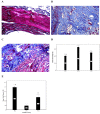The effect of Trolox on the rabbit anal sphincterotomy repair
- PMID: 37337166
- PMCID: PMC10280897
- DOI: 10.1186/s12876-023-02842-z
The effect of Trolox on the rabbit anal sphincterotomy repair
Abstract
Introduction: Fecal incontinence (FI) is caused by external anal sphincter injury. Vitamin E is a potential strategy for anal sphincter muscle repair via its antioxidant, anti-inflammatory, anti-fibrotic, and protective properties against myocyte loss. Thus, we aimed to evaluate the water-soluble form of vitamin E efficacy in repairing anal sphincter muscle defects in rabbits.
Methods: Twenty-one male rabbits were equally assigned to the intact (without any intervention), control (sphincterotomy), and Trolox (sphincterotomy + Trolox administration) groups. Ninety days after sphincterotomy, the resting and squeeze pressures were evaluated by manometry, and the number of motor units in the sphincterotomy site was calculated by electromyography. Also, the amount of muscle and collagen in the injury site was investigated by Mallory's trichrome staining.
Results: Ninety days after the intervention, the resting and squeeze pressures in the intact and Trolox groups were significantly higher than in the control group (P = 0.001). Moreover, the total collagen percentage of the sphincterotomy site was significantly lower in the Trolox group than in the control group (P = 0.002), and the total muscle percentage was significantly higher in the Trolox group compared to the control group (P = 0.001). Also, the motor unit number was higher in the Trolox group than in the control group (P = 0.001).
Conclusion: Trolox administration in the rabbit sphincterotomy model can decrease the amount of collagen and increase muscle, leading to improved anal sphincter electromyography and manometry results. Therefore, Trolox is a potential treatment strategy for FI.
Keywords: External anal sphincter; Fecal incontinence; Rabbit; Trolox.
© 2023. The Author(s).
Conflict of interest statement
The authors declare that they have no competing interests.
Figures



Similar articles
-
Functional external anal sphincter reconstruction for treatment of anal incontinence using muscle progenitor cell auto grafting.Dis Colon Rectum. 2010 Oct;53(10):1415-21. doi: 10.1007/DCR.0b013e3181e53088. Dis Colon Rectum. 2010. PMID: 20847624
-
Combination of laser and human adipose-derived stem cells in repair of rabbit anal sphincter injury: a new therapeutic approach.Stem Cell Res Ther. 2019 Dec 2;10(1):367. doi: 10.1186/s13287-019-1477-5. Stem Cell Res Ther. 2019. PMID: 31791407 Free PMC article.
-
Combined application of chondroitinase ABC and photobiomodulation with low-intensity laser on the anal sphincter repair in rabbit.BMC Gastroenterol. 2021 Dec 15;21(1):473. doi: 10.1186/s12876-021-02047-2. BMC Gastroenterol. 2021. PMID: 34911454 Free PMC article.
-
Patterns of fecal incontinence after anal surgery.Dis Colon Rectum. 2004 Oct;47(10):1643-9. doi: 10.1007/s10350-004-0651-7. Dis Colon Rectum. 2004. PMID: 15540293
-
Fecal incontinence. Studies on physiology, pathophysiology and surgical treatment.Dan Med Bull. 2003 Aug;50(3):262-82. Dan Med Bull. 2003. PMID: 13677243 Review.
References
-
- Regureos SR, Mangir N, Bissoli J, Osman NI, Bullock AJ, Chapple CR, MacNeil S. biomimetic design of an autologous cell seeded scaffold for pelvic floor repair. eur urol suppl. 2014;13:e486. doi: 10.1016/S1569-9056(14)60479-6. - DOI
-
- Ahmadibatool As, Mahjobibahar, Mirzaeirezvan M. Prevalence of fecal outlet obstruction and its predisposing factors in women aged 40 years and older: an epidemiological study. Iran J Ageing. 2011;5(18):7–13.
MeSH terms
Substances
LinkOut - more resources
Full Text Sources

